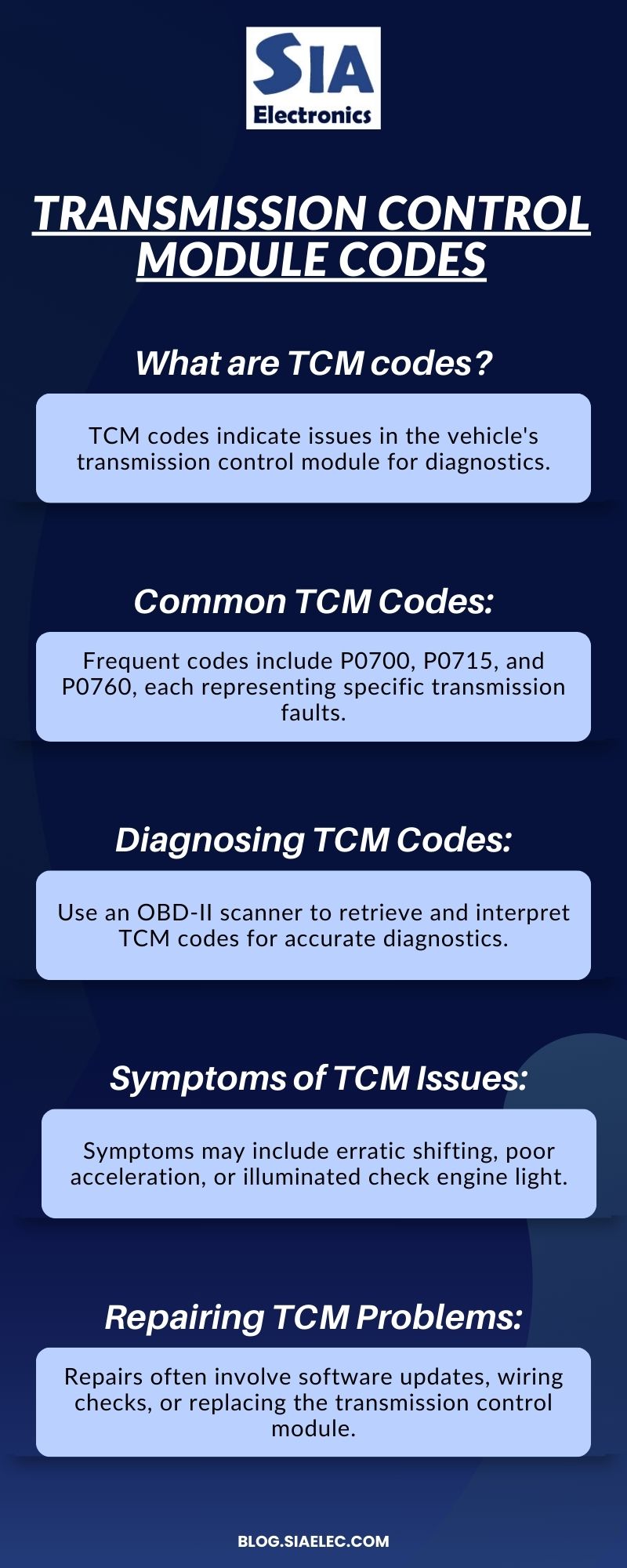Introduction
Transmission Control Module (TCM) codes are vital for diagnosing and resolving issues related to a vehicle's transmission system. These codes help identify specific problems and guide technicians in repairing or replacing faulty components. With over 20 years of experience, SIA Electronics is at the forefront of re-manufacturing automotive electronic control modules and ECUs, including those for transmission systems. Our expertise extends to mass air flow sensors, anti-lock brake computers (EBCMs), and hydraulic units, ensuring top-quality service for all domestic and foreign vehicles.
In this blog, we'll delve into TCM codes, exploring their meanings, common causes, diagnostic methods, and essential tools. By understanding these aspects, you can better address transmission issues and maintain your vehicle's performance.
Table of Contents
Introduction
Transmission Control Module (TCM) codes are vital for diagnosing and resolving issues related to a vehicle's transmission system. These codes help identify specific problems and guide technicians in repairing or replacing faulty components. With over 20 years of experience, SIA Electronics is at the forefront of re-manufacturing automotive electronic control modules and ECUs, including those for transmission systems. Our expertise extends to mass air flow sensors, anti-lock brake computers (EBCMs), and hydraulic units, ensuring top-quality service for all domestic and foreign vehicles.
In this blog, we'll delve into TCM codes, exploring their meanings, common causes, diagnostic methods, and essential tools. By understanding these aspects, you can better address transmission issues and maintain your vehicle's performance.
What Are Transmission Control Module (TCM) Codes?
Transmission Control Module (TCM) codes are diagnostic trouble codes (DTCs) that the vehicle’s onboard computer system generates when it detects a problem with the transmission system. These codes are crucial for identifying issues related to the transmission's electronic controls, sensors, and actuators.
- Purpose: TCM codes help in pinpointing malfunctions within the transmission control system.
- Format: Codes are usually alphanumeric (e.g., P0700, P0780).
- Diagnostic Role: They provide specific information about the nature and location of the problem.
Common Causes for Transmission Control Module Codes
Understanding the common causes of TCM codes is essential for effective troubleshooting. Here are some frequent reasons for these codes:
- Faulty Sensors: Sensors that monitor various aspects of transmission performance can fail, triggering TCM codes.
- Wiring Issues: Damaged or corroded wiring can lead to incorrect signals and trigger diagnostic codes.
- Transmission Fluid Problems: Low or dirty transmission fluid can cause the transmission to malfunction and generate TCM codes.
- Failed Solenoids: Transmission solenoids control fluid flow within the transmission; if they fail, TCM codes may be set.
- Mechanical Failures: Internal transmission components like gears and clutches can wear out or break, affecting performance and generating codes.
- Software Issues: Sometimes, software glitches or outdated firmware in the TCM can lead to incorrect codes.
How to Diagnose Transmission Control Module Codes
Diagnosing TCM codes involves a systematic approach to identify the root cause of the issue. Follow these steps for an accurate diagnosis:
- Retrieve the Code: Use an OBD-II scanner to read the TCM code from your vehicle's onboard computer.
- Interpret the Code: Look up the code in a service manual or online database to understand its meaning and implications.
- Inspect Components: Check related sensors, wiring, and fluids for any visible issues or malfunctions.
- Perform Tests: Run diagnostic tests using specialized tools to assess the performance of the transmission components.
- Check for Software Updates: Ensure that the TCM software is up to date, as outdated software can sometimes trigger false codes.
- Consult a Professional: If the issue persists or is complex, seek help from a qualified technician to perform a thorough inspection and repair.
To effectively diagnose and address TCM codes, you'll need specific tools:
- OBD-II Scanner: This is the primary tool for reading TCM and other diagnostic trouble codes from the vehicle's onboard computer.
- Diagnostic Software: Software compatible with the OBD-II scanner can provide detailed code definitions and troubleshooting information.
- Multimeter: Useful for checking electrical signals and diagnosing wiring issues.
- Transmission Fluid Pressure Gauge: Helps in measuring fluid pressure and diagnosing related issues.
- Repair Manual: A service manual specific to your vehicle can provide code interpretations and repair procedures.
Difference Between TCM Codes and Transmission Codes
While TCM codes and transmission codes may seem similar, they have distinct differences:
- TCM Codes: Specifically refer to issues within the transmission control module or its related systems. They focus on electronic control and sensor problems.
- Transmission Codes: Broader term that includes all codes related to transmission performance, including mechanical failures, fluid issues, and more.
In essence, TCM codes are a subset of transmission codes, focusing on electronic and control system faults.
Conclusion
Understanding Transmission Control Module (TCM) codes is essential for effective vehicle maintenance and repair. These codes provide valuable insights into the functioning of the transmission control system and help in diagnosing issues promptly. By using the right tools and following systematic diagnostic procedures, you can address these codes effectively.
At SIA Electronics, we are dedicated to providing top-notch re-manufacturing services for automotive electronic control modules, including transmission systems. With over two decades of experience, we ensure that your vehicle's electronic components are in optimal condition, enhancing performance and reliability.
FAQs on
Transmission Control Module Codes: Understanding and Diagnostics
-
1. What does a TCM code indicate about my vehicle?
Ans.
A TCM code indicates a problem within the transmission control module or related systems. It helps in diagnosing issues related to sensors, wiring, fluid levels, and other components.
-
2. Can I fix TCM code issues myself, or should I consult a professional?
Ans.
While some minor issues can be addressed with basic tools, consulting a professional is recommended for complex problems or if you’re unsure about the diagnosis and repair.
-
3. How often should I check for TCM codes?
Ans.
It’s advisable to check for TCM codes if you notice transmission issues such as slipping, rough shifting, or unusual noises. Regular maintenance checks can also help prevent problems.
-
4. Are there any preventive measures to avoid TCM code issues?
Ans.
Regular maintenance, including fluid changes, sensor inspections, and timely software updates, can help prevent TCM code issues.
-
5. How do I interpret TCM codes using an OBD-II scanner?
Ans.
An OBD-II scanner retrieves TCM codes from your vehicle's onboard computer. Use the scanner’s interface to look up code definitions and follow the diagnostic procedures provided.
-
6. What should I do if my TCM code keeps returning after repair?
Ans.
If the TCM code persists, it may indicate an underlying issue that wasn’t addressed or a new problem. Seek further diagnosis from a qualified technician to resolve the issue.



